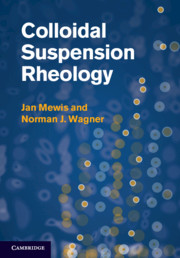Book contents
- Frontmatter
- Contents
- Preface
- General list of symbols
- Useful physical constants and values
- 1 Introduction to colloid science and rheology
- 2 Hydrodynamic effects
- 3 Brownian hard spheres
- 4 Stable systems
- 5 Non-spherical particles
- 6 Colloidal attractions and flocculated dispersions
- 7 Thixotropy
- 8 Shear thickening
- 9 Rheometry of suspensions
- 10 Suspensions in viscoelastic media
- 11 Advanced topics
- Index
- References
7 - Thixotropy
Published online by Cambridge University Press: 05 December 2011
- Frontmatter
- Contents
- Preface
- General list of symbols
- Useful physical constants and values
- 1 Introduction to colloid science and rheology
- 2 Hydrodynamic effects
- 3 Brownian hard spheres
- 4 Stable systems
- 5 Non-spherical particles
- 6 Colloidal attractions and flocculated dispersions
- 7 Thixotropy
- 8 Shear thickening
- 9 Rheometry of suspensions
- 10 Suspensions in viscoelastic media
- 11 Advanced topics
- Index
- References
Summary
Introduction
In earlier chapters it was shown that Brownian motion and colloidal interparticle forces give rise to viscoelastic effects. When a constant shear rate is applied to some colloidal suspensions, the viscosity can exhibit long transients, while viscoelastic features such as normal stress differences are hardly detectable. A well-known daily life example is provided by tomato ketchup: shaking turns it from a gel-like substance into a free-flowing liquid, but when left alone it will gradually stiffen and return to a gel. This is an example of the more general phenomenon known as thixotropy. It has been reported for a large number of colloidal products, some of which are listed in Table 7.1. They are most often colloidal glasses or gels at rest. Extensive lists of thixotropic products can be found in the literature [1–4]. Some products are actually formulated to exhibit a well-defined time evolution for viscosity recovery after shearing. Special additives (“thixotropic agents”) are available to induce and control such behavior. We note that many complex fluids such as some polymeric systems, liquid crystals and micellar systems exhibit thixotropy; however, these interesting materials are beyond our scope.
There is an extensive body of papers on thixotropy, scattered over the scientific and technical literature, including some reviews [1–5]. Nevertheless, the subject has been essentially ignored in rational continuum mechanics and, until recently, in colloid science. An explanation can perhaps be found in the persistent ambiguity about its definition, the lack of suitable model systems for study, and the complexity of the phenomenon, which includes serious measurement challenges. The more recent interest in glasses and gels within the general area of soft condensed matter is providing new terminology in the field, such as aging and shear rejuvenation [6]. This chapter provides a guide to understanding thixotropy in colloidal suspensions and an introduction to its modeling.
- Type
- Chapter
- Information
- Colloidal Suspension Rheology , pp. 228 - 251Publisher: Cambridge University PressPrint publication year: 2011
References
- 7
- Cited by



